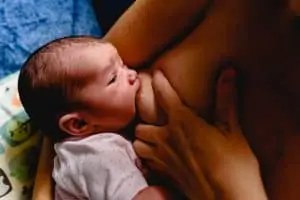Going through TSA is a pain in the butt without needing to pump breastmilk, but when you’re faced with the task of flying with breastmilk, you face a lot of questions and concerns.
Flying with a baby or children, in general, is no small or easy feat. Add in taking a pump, your baby, pumped milk, and everything else, and it’s no wonder you might develop a headache through it all. Luckily, I can tell you that you can and will make it through the airport without needing to dump out your precious breast milk!
Not too long ago, I had to leave my baby to attend a funeral, and that meant I needed to take my pump with me. While I only had my oldest child with me, so it was a bit easier, I still had to figure out how to get my breast milk through TSA without needing to dump it out.
Here is what I learned when I was flying with breast milk.
Do I Need to Travel with My Baby?
This was quite a concern for me since I was pumping without a baby with me. Would they believe me? Would they let me bring my milk home with me?
Thankfully, in the United States, regulations state that you do not need to have your baby with you to travel. That was a massive relief for me when I was traveling to a funeral, but working moms who need to travel as well can continue to pump on the go.
However, this doesn’t always apply to international policies. Some countries do stipulate that your baby needs to be with you. Always check the rules of the country that you are visiting.
How Much Breast Milk Can You Bring With You
The first thing that I learned is that each country does have its regulations, so if you plan to fly out of the country, you need to do some research.
The United States Regulations
When you travel to or throughout the United States, the TSA checks all of the passengers and carry-on bags before you board an airplane. The TSA regulations allow you to take liquids with you onboard if you keep them inside of your carry-on bags or personal bags.
There are some rules that you need to follow.
- The containers need to be 3.4 ounces (100 ml) or less.
- All of the containers need to fit into one clear quart-sized zipper bag.
The TSA has set some different regulations for parents who are flying when it comes to breast milk. You are allowed to carry amounts more than 3.4 ounces if you let the TSA officers know when you reach the inspection area.
Being upfront and honest is truly the best policy when it comes to flying. You need to understand your rights and the process. When you make it to inspections, an officer will look through the contents of your bag, as well as the container holding your breastmilk. According to the law, the officer could decide to test your breastmilk, but that is a case-by-case basis. I have yet to experience that.
Since I was only gone for two days, I was able to fit all of my breast milk into the zippered bag and declared it at the TSA inspection. The officers were polite, examined the contents of my carry-on bag, and I had no problems making it through quickly.
What About Other Countries?
You must do your research, and you can always reach out to the U.S. embassy in each country if you want to be sure of what is and isn’t permitted to avoid any issues.
Here is an example of what to expect if you’re traveling to or from the United Kingdom.
In the U.K., you can fly with breastmilk in your carry-on bag. The rules state that each container cannot hold more than 2000 ml. Frozen breastmilk needs to be kept inside of checked luggage rather than individual bags.
6 Tips for Flying with Breastmilk
Do you still feel nervous about flying with breastmilk? Here are some helpful tips to make the process easier and get you through TSA faster.
Use Different Zippered Bags
You shouldn’t keep your breast milk in the same quart zippered bag as your hairspray and shampoo. Put those in a different container to make the process easier. I typically keep my toiletries in my checked luggage rather than the ones I take with me.
Be Upfront
As I said before, honesty is the best policy, so let the officer who is helping you know that you do have breastmilk with you. They see this all of the time, so don’t feel embarrassed and don’t get frazzled. They see thousands of mothers facing the same thing.
Get It Out Early
I suggest that you take out the bag containing your bags of breastmilk before you reach inspection. You don’t want to be searching for it, fumbling in your bag. This also means you are letting them know ahead of time, and things will go smoother overall.
You Can Request Gloves
If the officer needs to touch the bottles of breast milk, don’t feel bad about requesting them to wear gloves. This is your baby’s food and should be handled appropriately. I made sure to ask that the officer changed into clean gloves.
Try Keeping It in Your Carry-On Bag Only
In an ideal situation, you will only have a small amount of breastmilk that fits into your carry-on bag or personal bag. You can use your checked-in luggage if you need more space.
You’re allowed to take frozen breast milk in your checked luggage if you need additional space after a long trip. They’ll ask at the counter, and you can let them know that the bag contains frozen bags of milk.
You Can Use Ice Packs
The TSA does allow you to bring coolers with ice packs or gel packs to keep your milk cold. Frozen breastmilk still needs to be screened as well.
You’ll need to contact the airline that you are using, such as Delta or American Airlines, to figure out if they count a cooler for breastmilk or a pump as a personal item. A breast pump is typically considered a medical device, and it’s a good idea to contact the airline 48-72 hours ahead of time to let them know you will have it with you.
Feel Confident
Flying with breastmilk is something that mothers face all the time. Don’t panic; if you prepare ahead of time, you’ll have no problems making it through TSA. Do your research before you fly international, but rest assured, the TSA in the United States does allow you to bring breast milk onboard!
Hey, this is Linda. My biggest accomplishment in life is being a mother of four children. Their current ages range from almost ten years old down to 20 months old.
I’m passionate about writing parenting articles because I understand so well all of the problems and trials you face as a parent. From breastfeeding woes to budgeting problems and behavior problems, along with everything in between, chances are I’ve faced it over the last ten years. Read more about Linda here.






